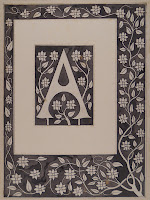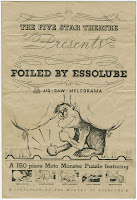 Though Aubrey Beardsley is perhaps best known for his more grotesque and erotic works, many of which were featured in illustrated editions of Oscar Wilde's writings, he was also involved in numerous other influential projects. One of these was the lavishly produced edition of Morte d'Arthur (London: J.M. Dent, 1893-1894) which was issued in 12 parts and included more than a thousand illustrations by Beardsley. The text was a reprint of the original William Caxton printing from 1485 with text by Sir Thomas Malory, but the spelling in this edition was updated to a more modern style - presumably to allow for easier reading.
Though Aubrey Beardsley is perhaps best known for his more grotesque and erotic works, many of which were featured in illustrated editions of Oscar Wilde's writings, he was also involved in numerous other influential projects. One of these was the lavishly produced edition of Morte d'Arthur (London: J.M. Dent, 1893-1894) which was issued in 12 parts and included more than a thousand illustrations by Beardsley. The text was a reprint of the original William Caxton printing from 1485 with text by Sir Thomas Malory, but the spelling in this edition was updated to a more modern style - presumably to allow for easier reading.  Shown here are both an original drawing and the final printed version of the illustrated chapter initial from book 13, chapter 1, which begins the story of the Grail and starts "At the vigil of Pentecost..." Though the original is unsigned, there is a note on the reverse which reads: "In my opinion this is a genuine drawing by Beardsley.--R.A. Walker (authority on Beardsley)"
Shown here are both an original drawing and the final printed version of the illustrated chapter initial from book 13, chapter 1, which begins the story of the Grail and starts "At the vigil of Pentecost..." Though the original is unsigned, there is a note on the reverse which reads: "In my opinion this is a genuine drawing by Beardsley.--R.A. Walker (authority on Beardsley)"To see the original drawing, ask for Iconography 212. To compare it to the printed version from the "superior issue", ask for Illus B38maja, vol 3. and turn to page 689.

